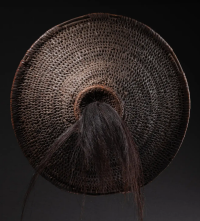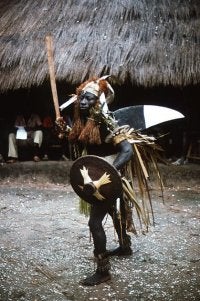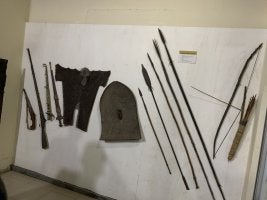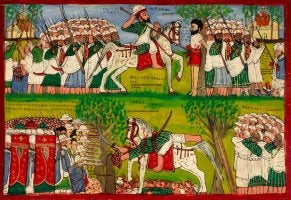Ahh I mixed those two up. Thanks.The second map is more accurate. Gao was never conquered by Ghana. The furthest extent of their influence was Tadmekka, in a war against whom the Almoravids assisted Ghana, though the result acording to al-Zuhri was that the Tadmekkans became Muslim, and by that date the now Muslim Wagadu had lost Awdaghust to the Almoravids.
You are using an out of date browser. It may not display this or other websites correctly.
You should upgrade or use an alternative browser.
You should upgrade or use an alternative browser.
Militaries of pre colonial africa
- Thread starter Joyboy13
- Start date
Joined Dec 2021
97 Posts | 278+
France
Here a rare and little-known type of Numidian shield, showcased on the San Omobono monument in Rome. The shield has a distinctive shape not found elsewhere in the Mediterranean basin, featuring a depiction of a winged serpent. It seems to be more of a votive or ceremonial shield.
The serpent-buckler (Figure 8.24) is not Roman, Greek, Celtic, German, Iranian or of any other ‘ethnic’ protagonist people in big Hellenistic and Roman histories whose arms or images of them are known. Whether or not Romans understood the specifics of its foreignness, the logical hypothesis is that the shield contour, in the larger context of Numidian resemblance, should be Numidian too.
The strange collage reminds of the mixture of culturally diverse canons of mimesis and outright stylisation on the North African mountain-markers and tombs discussed above. It is not possible for me to imagine a Greco-Roman Hellenistic artist conceiving such a guardian serpent without direction by someone thinking visually like a North African, and so, adding North African elements to the pantheon that the representations on the relief armours collectively present. Since the actual shield-shape has no analogue in any other context and as SO’s only extant formal and conceptual cousin is the Numidian monument genre, it seems a strong hypothesis that this winged serpent buckler is meant to be ‘Numidian’ votive armour. In this reading the fragment strengthens the case for collaborative design between artists aware of Numidian ideas and forms, and artists trained, as many details show, elsewhere in the Mediterranean.
Ann Kuttner, Representing Hellenistic Numidia: Africa and Rome, in: The Hellenistic West Rethinking the Ancient Mediterranean, Cambridge University Press, 2013


The serpent-buckler (Figure 8.24) is not Roman, Greek, Celtic, German, Iranian or of any other ‘ethnic’ protagonist people in big Hellenistic and Roman histories whose arms or images of them are known. Whether or not Romans understood the specifics of its foreignness, the logical hypothesis is that the shield contour, in the larger context of Numidian resemblance, should be Numidian too.
The strange collage reminds of the mixture of culturally diverse canons of mimesis and outright stylisation on the North African mountain-markers and tombs discussed above. It is not possible for me to imagine a Greco-Roman Hellenistic artist conceiving such a guardian serpent without direction by someone thinking visually like a North African, and so, adding North African elements to the pantheon that the representations on the relief armours collectively present. Since the actual shield-shape has no analogue in any other context and as SO’s only extant formal and conceptual cousin is the Numidian monument genre, it seems a strong hypothesis that this winged serpent buckler is meant to be ‘Numidian’ votive armour. In this reading the fragment strengthens the case for collaborative design between artists aware of Numidian ideas and forms, and artists trained, as many details show, elsewhere in the Mediterranean.
Ann Kuttner, Representing Hellenistic Numidia: Africa and Rome, in: The Hellenistic West Rethinking the Ancient Mediterranean, Cambridge University Press, 2013


Also, medieval Ethiopians seem to use less of this armor type compared to their close neighbors. Does anybody know why?Is lifidi stronger than a typical gambison and if so, what makes it stronger?
Joined Jan 2024
3,592 Posts | 5,495+
Spain
Is lifidi stronger than a typical gambison and if so, what makes it stronger?
Gambeson is a pretty loose word in what It means, and lifidi can be considered a type of gambeson. There were some lighter than lifidi and others on the same "heavy" class.
Last edited:
Would there have been different classes of lifidi as well? (Light/heavy), (Infantry/Cavalry) Also, do you have any sources that talk about the history of Lifidi and the construction of it. If so can you please share.Gambeson is a pretty loose word in what It means, and lifidi can be considered a type of gambeson. There were some lighter than lifidi and others on the same "heavy" class.
“Warfare in the Sokoto Caliphate” by Joseph P. Smaldone touches a bit on lifidi used by cavalry and infantry.
“Arms and Armor in the Warfare of Pre-Colonial Hausaland” by the Ahmadu Bello University
Joined Jan 2024
3,592 Posts | 5,495+
Spain
Would there have been different classes of lifidi as well? (Light/heavy), (Infantry/Cavalry) Also, do you have any sources that talk about the history of Lifidi and the construction of it. If so can you please share.
“Warfare in the Sokoto Caliphate” by Joseph P. Smaldone touches a bit on lifidi used by cavalry and infantry.
“Arms and Armor in the Warfare of Pre-Colonial Hausaland” by the Ahmadu Bello University
About the first question, probably yes, but I don't have specific information.
Joined Jan 2024
3,592 Posts | 5,495+
Spain
Joined Jan 2024
3,592 Posts | 5,495+
Spain
Joined Jan 2024
3,592 Posts | 5,495+
Spain
The chief of Fada N'gourma, in Gourma. The first photo, with his mounted escort, was already posted in the thread, but not the second one. The leather accoutrements for the horse that were popular as horse armour for the Mossi/Bariba/Dagomba can be seen, but these ones are quite fancy.

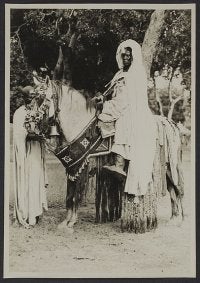
A group of Mossi cavalrymen:

And finally, some Bariba cavalry. Some of their horses are protected by leather barding, similar to the photos above:
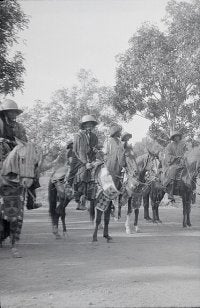
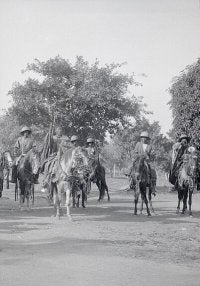


A group of Mossi cavalrymen:

And finally, some Bariba cavalry. Some of their horses are protected by leather barding, similar to the photos above:


Joined Jan 2024
3,592 Posts | 5,495+
Spain
Joined Jul 2021
2,391 Posts | 2,067+
The Other Side
Joined Feb 2018
547 Posts | 870+
California
Attachments
Joined Feb 2018
547 Posts | 870+
California
Looking back on this, you were overreacting to me wanting to see stuff from beyond whatever you had in your folder, you got mad then straw manned me with points I never made because I struck a never and you got reflexively defensive, you didn’t need to respond, I never made any disparaging remarks, and you were mad because you felt insecure over whateverMaybe I'm just horribly misunderstanding this sentence:
Ok, but I've never once said that there isn't more to Africa than the 19th and 20th centuries. You can check my posts. I've posted a lot about all periods of African history. And I really just don't understand the part about the slave trade... Maybe you can rephrase the sentence for me?
Yes, I didn't use the word in the political sense, and so I may have misused it here. What I was trying to say is that, when I look at your posts, threads, questions, it really feels like you're reacting/responding to Eurocentric garbage, which compromises the authenticity of the research, while I'm trying to ignore the Eurocentric garbage and simply study Africa from an African perspective, which, whether you like it or not, also involves Europeans and their 19th century accounts of the continent, because they're sometimes all we have left of a bygone era. I'm just looking at the images for valuable anthropological data which is often relevant for earlier periods as well, and all the personal names, place names, maps, cultural, religious, linguistic, ethnic and political descriptions are simply of an immeasurable value. Me posting about those periods doesn't mean that you, or anybody else can't post about any other period, as I have done myself, including in this thread.
I did react strongly, because you made three seemingly disparaging comments in a row about 19th century African history, immediately after I posted 19th century African history. History which was really difficult to come by. A lot of these aren't just downloaded and uploaded. A lot goes into finding, verifying, cross-checking, contextualizing and even some digital restoration of scans of +120 year old books. So I'm invested in it. And many interactions on this forum over the past months have greatly increased certain fields of interest for me, and I've come to learn many new things, so it's paying dividends. When it feels like I'm being told not talk about a certain subject I'm invested in, because it makes someone uncomfortable, then I tend to double down on it...
Maybe I overreacted and should have just ignored the comments. Maybe I just woke up on the wrong side of the bed. Either way, I'm going to continue to post about 19th century Africa, and every other period in precolonial African history, as I have been doing for a while now, and I sincerely hope that it stops bothering you.
You're right...
Joined Feb 2018
547 Posts | 870+
California
Nah no what this was a pointless argument and response tbh if mods want to they can delete thisLooking back on this, you were overreacting to me wanting to see stuff from beyond whatever you had in your folder, you got mad then straw manned me with points I never made because I struck a never and you got reflexively defensive, you didn’t need to respond, I never made any disparaging remarks, and you were mad because you felt insecure over whatever
Joined Feb 2018
547 Posts | 870+
California
Joined Feb 2018
547 Posts | 870+
California
Joined Feb 2018
547 Posts | 870+
California
Joined Nov 2024
47 Posts | 106+
Netherlands
Do you know which museum this photo was taken or wich empire this armor is from?
Joined Sep 2024
122 Posts | 454+
USA
National Commission for Museums and Monuments, Kaduna, NigeriaDo you know which museum this photo was taken or wich empire this armor is from?
More History Discussions
- Replies
- 93
- Views
- 10K
- Replies
- 43
- Views
- 13K
- Replies
- 107
- Views
- 10K
- Replies
- 26
- Views
- 5K
Trending History Discussions
-
The Great Captains of History - How Many Battles? - Version 7
- Started by DiocletianIsBetterThanYou
- Replies: 861
-
-
The Great Captains of History - How Many Battles? - Version 5
- Started by DiocletianIsBetterThanYou
- Replies: 3K
-
The Diversity Of Early African Architecture/Ruins Thread
- Started by Kilwa Sultanate
- Replies: 2K
-







